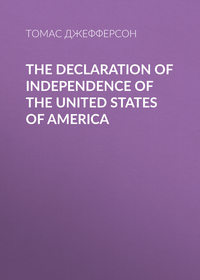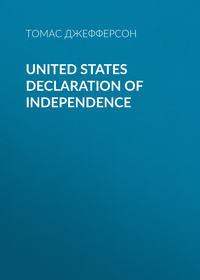 полная версия
полная версияMemoir, Correspondence, And Miscellanies, From The Papers Of Thomas Jefferson, Volume 2
May 11. Montpelier. Snow on the Cevennes, still visible from here. With respect to the muscat grape, of which the wine is made, there are two kinds, the red and the white. The first has a red skin, but a white juice. If it be fermented in the cuve, the coloring matter which resides in the skin, is imparted to the wine. If not fermented in the cuve, the wine is white. Of the white grape, only a white wine can be made. The species of saintfoin cultivated here by the name of sparsette, is the hedysarum onobrychis. They cultivate a great deal of madder (garance) rubia tinctorum here, which is said to be immensely profitable. Monsieur de Gouan tells me, that the pine, of which they use the burs for fuel, is the pinus sativus, being two-leaved. They use-for an edging to the borders of their gardens, the santolina, which they call garderobe. I find the yellow clover here, in a garden, and the large pigeon succeeding well, confined in a house.
May 12. Frontignan. Some tolerably good plains in olives, vines, corn, saintfoin, and lucerne. A great proportion of the hills are waste. There are some enclosures of stone, and some sheep. The first four years of madder are unproductive; the fifth and sixth yield the whole value of the land. Then it must be renewed. The sparsette is the common or true saintfoin. It lasts about five years: in the best land it is cut twice, in May and September, and yields three thousand pounds of dry hay to the setterie, the first cutting, and five hundred pounds, the second. The setterie is of seventy-five dextres en tout sens, supposed about two arpents. Lucerne is the best of all forage; it is sowed herein the broad-cast, and lasts about twelve or fourteen years. It is cut four times a year, and yields six thousand pounds of dry hay, at the four cuttings, to the setterie. The territory in which the vin muscat de Frontignan is made, is about a league of three thousand toises long, and one fourth of a league broad. The soil is reddish and stony, often as much stone as soil. On the left, it is a plain, on the right hills. There are made about one thousand pièces (of two hundred and fifty bottles each) annually, of which six hundred are of the first quality, made on the coteaux. Of these, Madame Soubeinan makes two hundred, Monsieur Reboulle ninety, Monsieur Lambert, medecin de la faculte de Montpelier, sixty, Monsieur Thomas, notaire, fifty, Monsieur Argilliers fifty, Monsieur Audibert forty; equal to four hundred and ninety; and there are some small proprietors who make small quantities. The first quality is sold, brut, for one hundred and twenty livres the pièce; but it is then thick, and must have a winter and the fouet, to render it potable and brilliant. The fouet is like a chocolate-mill, the handle of iron, the brush of stiff hair. In bottles, this wine costs twenty-four sous, the bottle, &c. included. It is potable the April after it is made, is best that year, and after ten years begins to have a pitchy taste, resembling it to Malaga. It is not permitted to ferment more than half a day, because it would not be so liquorish. The best color, and its natural one, is the amber. By force of whipping, it is made white, but loses flavor. There are but two or three pièces a year of red Muscat made; there being but one vineyard of the red grape, which belongs to a baker called Pascal. This sells in bottles at thirty sous, the bottle included. Rondelle, négociant en vin, Porte St. Bernard, fauxbourg St. Germain, Paris, buys three hundred pieces of the first quality every year. The coteaux yield about half a piece to the setterie, the plains a whole piece. The inferior quality is not at all esteemed. It is bought by the merchants of Cette, as is also the wine of Beziers, and sold by them for Frontignan of the first quality. They sell thirty thousand pièces a year under that name. The town of Frontignan marks its casks with a hot iron: an individual of that place, having two casks emptied, was offered forty livres for the empty cask by a merchant of Cette. The town of Frontignan contains about two thousand inhabitants; it is almost on the level of the ocean. Transportation to Paris is fifteen livres the quintal, and takes fifteen days. The price of packages is about eight livres eight sous the one hundred bottles. A setterie of good vineyard sells for from three hundred and fifty to five hundred livres, and rents for fifty livres. A laboring man hires at one hundred and fifty livres the year, and is fed and lodged; a woman at half as much. Wheat sells at ten livres the settier, which weighs one hundred pounds, poids de table. They make some Indian corn here, which is eaten by the poor. The olives do not extend northward of this into the country above twelve or fifteen leagues. In general, the olive country in Languedoc is about fifteen leagues broad. More of the waste lands between Frontignan and Mirval are capable of culture; but it is a marshy country, very subject to fever and ague, and generally unhealthy. Thence arises, as is said, a want of hands.
Cette. There are in this town about ten thousand inhabitants. Its principal commerce is wine; it furnishes great quantities of grape-pumice for making verdigrise. They have a very growing commerce; but it is kept under by the privileges of Marseilles.
May 13. Agde. On the right of the Etang de Thau are plains of some width, then hills, in olives, vines, mulberry, corn, and pasture. On the left a narrow sand-bar, separating the Etang from the sea, along which it is proposed to make a road from Cette to Agde. In this case, the post would lead from Montpelier by Cette and Agde to Beziers, being leveller, and an hour or an hour and a half nearer. Agde contains six or eight thousand inhabitants.
May 14. Beziers. Rich plains in corn, saintfoin, and pasture; hills at a little distance to the right in olives; the soil both of hill and plain is red going from Agde to Beziers. But at Beziers the country becomes hilly, and is in olives, corn, saintfoin, pasture, some vines, and mulberries.
May 15. Beziers. Argilies. Le Saumal. From Argilies to Saumal are considerable plantations of vines. Those on the red hills, to the right, are said to produce good wine. No wood, no enclosures. There are sheep and good cattle. The Pyrenees are covered with snow. I am told they are so in certain parts all the year. The canal of Languedoc, along which I now travel, is six toises wide at bottom, and ten toises at the surface of the water, which is one toise deep. The barks which navigate it are seventy and eighty feet long, and seventeen or eighteen feet wide. They are drawn by one horse, and worked by two hands, one of which is generally a woman. The locks are mostly kept by women, but the necessary operations are much too laborious for them. The encroachments by the men, on the offices proper for the women, is a great derangement in the order of things. Men are shoemakers, tailors, upholsterers, staymakers, mantua-makers, cooks, housekeepers, house-cleaners, bed-makers, they coiffe the ladies, and bring them to bed: the women, therefore, to live, are obliged to undertake the offices which they abandon. They become porters, carters, reapers, sailors, lock-keepers, smiters on the anvil, cultivators of the earth, &c. Can we wonder, if such of them as have a little beauty, prefer easier courses to get their livelihood, as long as that beauty lasts? Ladies who employ men in the offices which should be reserved for their sex, are they not bawds in effect? For every man whom they thus emply, some girl, whose place he has thus taken, is driven to whoredom. The passage of the eight locks at Beziers, that is, from the opening of the first to the last gate took one hour and thirty-three minutes. The bark in which I go is about thirty-five feet long, drawn by one horse, and goes from two to three geographical miles an hour. The canal yields abundance of carp and eel. I see also small fish, resembling our perch and chub. Some plants of white clover, and some of yellow, on the banks of the canal near Capestan; santolina also, and a great deal of yellow iris. Met a raft of about three hundred and fifty beams, forty feet long, and twelve or thirteen inches in diameter, formed into fourteen rafts, tacked together. The extensive and numerous fields of saintfoin, in general bloom, are beautiful.
May 16. Le Saumal. Marseillette. May 17. Marseilleite. Carcassonne. From Saumal to Carcassonne we have always the river Aube close on our left. This river runs in the valley between the Cevennes and Pyrenees, serving as the common receptacle for both their waters. It is from fifty to one hundred and fifty yards wide, always rapid, rocky, and insusceptible of navigation. The canal passes in the side of hills made by that river, overlooks the river itself, and its plains, and has its prospect ultimately terminated on one side by mountains of rock, overtopped by the Pyrenees, on the other by small mountains, sometimes of rock, sometimes of soil, overtopped by the Cevennes. Marseillette is on a ridge, which separates the river Aube from the Etang de Marseillette. The canal, in its approach to this village, passes the ridge, and rides along the front, overlooking the Etang, and the plains on its border; and having passed the village, re-crosses the ridge, and resumes its general ground in front of the Aube. The land is in corn, saintfoin, pasture, vines, mulberries, willows, and olives.
May 18. Carcassonne. Castelnaudari. Opposite to Carcassonne the canal receives the river Fresquel, about thirty yards wide, which is its substantial supply of water from hence to Beziers. From Beziers to Agde the river Orb furnishes it, and the Eraut, from Agde to the Etang de Thau. By means of the écluse ronde at Agde, the waters of the Eraut can be thrown towards Beziers, to aid those of the Orb, as far as the écluse de Porcaraigne, nine geometrical miles. Where the Fresquel enters the canal, there is, on the opposite side, a waste, to let off the superfluous waters. The horse-way is continued over this waste, by a bridge of stone of eighteen arches. I observe them fishing in the canal, with a skimming net of about fifteen feet diameter, with which they tell me they catch carp. Flax in blossom. Neither strawberries nor peas yet at Carcassonne. The Windsor-bean just come to table. From the écluse de la Lande we see the last olive trees near a metairée, or farm-house-, called La Lande. On a review of what I have seen and heard of this tree, the following seem to be its northern limits. Beginning on the Atlantic, at the Pyrenees, and along them to the meridian of La Lande, or of Carcassonne; up that meridian to the Cevennes, as they begin just there to raise themselves high enough to afford it shelter. Along the Cevennes, to the parallel of forty-five degrees of latitude, and along that parallel (crossing the Rhone near the mouth of the Isere) to the Alps; thence along the Alps and Apennines, to what parallel of latitude I know not. Yet here the tracing of the line becomes the most interesting. For from the Atlantic, so far we see this production the effect of shelter and latitude combined. But where does it venture to launch forth unprotected by shelter, and by the mere force of latitude alone? Where, for instance, does its northern limit cross the Adriatic? I learn, that the olive tree resists cold to eight degrees of Reaumur below the freezing-point, which corresponds to fourteen above zero of Fahrenheit: and that the orange resists to four degrees below freezing of Reaumur, which is twenty-three degrees above zero of Fahrenheit.
May 19. Castelnaudari. St. Feriol. Escamaze. Lampy. Some sheep and cattle; no enclosures. St. Feriol, Escamaze, and Lampy are in the montagnes noires. The country almost entirely waste. Some of it in shrubbery. The voute d’Escamaze is of one hundred and thirty-five yards. Round about Castelnaudari the country is hilly, as it has been constantly from Beziers; it is very rich. Where it is plain, or nearly plain, the soil is black: in general, however, it is hilly and reddish, and in corn. They cultivate a great deal of Indian corn here, which they call millet; it is planted, but not yet up.
May 20. Castelnaudari. Naurouze. Villefranche. Baziege. At Naurouze is the highest ground which the canal had to pass between the two seas. It became necessary, then, to find water still higher to bring it here. The river Fresquel heading by its two principal branches in the montagnes noires, a considerable distance off to the eastward, the springs of the most western one were brought together, and conducted to Naurouze, where its waters are divided, part furnishing the canal towards the ocean, the rest towards the Mediterranean, as far as the écluse de Fresquel, where, as has been before noted, the Lampy branch and the Alzau, under the name of the Fresquel, enter.
May 20. They have found that a lock of six pieds is best; however, eight pieds is well enough. Beyond this, it is bad. Monsieur Pin tells me of a lock of thirty pieds made in Sweden, of which it is impossible to open the gates. They therefore divided it into four locks. The small gates of the locks of this canal have six square pieds of surface. They tried the machinery of the jack for opening them. They were more easily opened, but very subject to be deranged, however strongly made. They returned, therefore, to the original wooden screw, which is excessively slow and laborious. I calculate that five minutes are lost at every basin by this screw, which, on the whole number of basins, is one eighth of the time necessary to navigate the canal: and of course, if a method of lifting the gate at one stroke could be found, it would reduce the passage from eight to seven days, and the freight equally. I suggested to Monsieur Pin and others a quadrantal gate, turning on a pivot, and lifted by a lever like a pump-handle, aided by a windlass and cord, if necessary. He will try it, and inform me of the success. The price of transportation from Cette to Bordeaux, through the canal and Garonne is – the quintal: round by the straits of Gibraltar is –. Two hundred and forty barks, the largest of twenty-two hundred quintals (or say, in general, of one hundred tons), suffice to perform the business of this canal, which is stationary, having neither increased nor diminished for many years. When pressed, they can pass and repass between Toulouse and Beziers in fourteen days; but sixteen is the common period. The canal is navigated ten and a half months of the year: the other month and a half being necessary to lay it dry, cleanse it, and repair the works. This is done in July and August, when there would perhaps be a want of water.
May 21. Baziège. Toulouse. The country continues hilly, but very rich. It is in mulberries, willows, some vines, corn, maize, pasture, beans, flax. A great number of chateaux and good houses in the neighborhood of the canal. The people partly in farm-houses, partly in villages. I suspect that the farm-houses are occupied by the farmers, while the laborers (who are mostly by the day) reside in the villages. Neither strawberries nor pease yet at Baziege or Toulouse. Near the latter are some fields of yellow clover.
At Toulouse the canal ends. It has four communications with the Mediterranean. 1. Through the ponds of Thau, Frontignan, Palavas, Maguelone, and Manjo, the canal de la Radela Aigues-mortes, le canal des Salines de Pecair, and the arm of the Rhone called Bras de Fer, which ends at Fourgues, opposite to Arles, and thence down the Rhone. 2. At Cette, by a canal of a few hundred toises, leading out of the Etang de Thau into the sea. The vessels pass the Etang, though a length of nine thousand toises, with sails. 3. At Agde, by the river Eraut, twenty-five hundred toises. It has but five or six pieds of water at its mouth. It is joined to the canal at the upper part of this communication, by a branch of a canal two hundred and seventy toises long. 4. At Narbonne, by a canal they are now opening, which leads from the great canal near the aqueduct of the river Cesse, twenty-six hundred toises, into the Aude. This new canal will have five lock-basins, of about twelve pieds fall each. Then you are to cross the Aude very obliquely, and descend a branch of it six thousand toises, through four lock-basins to Narbonne, and from Narbonne down the same branch, twelve hundred toises into the Etang de Sigen, across that Etang four thousand toises, issuing at an inlet, called Grau de la Nouvelle, into the Gulf of Lyons. But only vessels of thirty or forty tons can enter this inlet. Of these four communications, that of Cette only leads to a deep sea-port, because the exit is there by a canal, and not a river. Those by the Rhone, Eraut, and Aude, are blocked up by bars at the mouths of those rivers. It is remarkable, that all the rivers running into the Mediterranean are obstructed at their entrance by bars and shallows, which often change their position. This is the case with the Nile, Tiber, the Po, the Lez, le Lyoron, the Orbe, the Gly, the Tech, the Tet, he. Indeed, the formation of these bars seems not confined to the mouths of the rivers, though it takes place at them more certainly. Along almost the whole of the coast, from Marseilles towards the Pyrenees, banks of sand are thrown up parallel with the coast, which have insulated portions of the sea, that is, formed them into etangs, ponds, or sounds, through which here and there narrow and shallow inlets only are preserved by the currents of the rivers. These sounds fill up in time, with the mud and sand deposited in them by the rivers. Thus the Etang de Vendres, navigated formerly by vessels of sixty tons, is now nearly filled up by the mud and sand of the Aude. The Vistre and Vidourle, which formerly emptied themselves into the Gulf of Lyons, are now received by the Etangs de Manjo and Aiguesmortes, that is to say, the part of the Gulf of Lyons, which formerly received, and still receives those rivers, is now cut off from the sea by a bar of sand, which has been thrown up in it, and has formed it into sounds. Other proofs that the land gains there on the sea, are, that the towns of St. Giles and Notre Dame d’Asposts, formerly seaports, are no far from the sea, and that Aiguesmortes, where are still to be seen the iron rings to which vessels were formerly moored, and where St. Louis embarked for Palestine, has now in its vicinities only ponds, which cannot be navigated, and communicates with the sea by an inlet, called Grau du Roy, through which only fishing-barks can pass. It is pretty well established, that all the Delta of Egypt has been formed by the depositions of the Nile, and the alluvions of the sea, and it is probable that that operation is still going on. Has this peculiarity of the Mediterranean any connection with the scantiness of its tides, which, even at the equinoxes, are of two or three feet only? The communication from the western end of the canal to the ocean, is by the river Garonne. This is navigated by flat boats of eight hundred quintals, when the water is well; but when it is scanty, these boats carry only two hundred quintals, till they get to the mouth of the Tarn. It has been proposed to open a canal that far from Toulouse, along the right side of the river.
May 22. Toulouse. 23. Agen. 24. Castres. Bordeaux. The Garonne, and rivers emptying into it, make extensive and rich plains, which are in mulberries, willows, corn, maize, pasture, beans, and flax. The hills are in corn, maize, beans, and a considerable proportion of vines. There seems to be as much maize as corn in this country. Of the latter, there is more rye than wheat. The maize is now up, and about three inches high. It is sowed in rows two feet or two and a half feet apart, and is pretty thick in the row. Doubtless they mean to thin it. There is a great deal of a forage they call farouche. It is a species of red trefoil, with few leaves, a very coarse stalk, and a cylindrical blossom of two inches in length, and three quarters of an inch in diameter, consisting of floscules, exactly as does that of the red clover. It seems to be a coarse food, but very plentiful. They say it is for their oxen. These are very fine, large, and cream-colored. The services of the farm and of transportation are performed chiefly by them. There are a few horses and asses, but no mules. Even in the city of Bordeaux we see scarcely any beasts of draught but oxen. When we cross the Garonne at Langon, we find the plains entirely of sand and gravel, and they continue so to Bordeaux. Where they are capable of any thing, they are in vines, which are in rows, four, five, or six feet apart, and sometimes more. Near Langon is Sauterne, where the best white wines of Bordeaux are made. The waste lands are in fern, furze, shrubbery, and dwarf trees. The farmers live on their farms. At Agen, Castres, Bordeaux, strawberries and pease are now brought to table; so that the country on the canal of Languedoc seems to have later seasons than that east and west of it. What can be the cause? To the eastward, the protection of the Cevennes makes the warm season advance sooner. Does the neighborhood of the Mediterranean co-operate? And does that of the ocean mollify and advance the season to the westward? There are ortolans at Agen, but none at Bordeaux. The buildings on the canal and the Garonne are mostly of brick, the size of the bricks the same with that of the ancient Roman brick, as seen in the remains of their buildings in this country. In those of a circus at Bordeaux, considerable portions of which are standing, I measured the bricks, and found them nineteen or twenty inches long, eleven or twelve inches wide, and from one and a half to two inches thick; their texture as fine, compact, and solid as that of porcelain. The bricks now made, though of the same dimensions, are not so fine. They are burnt in a kind of furnace, and make excellent work. The elm tree shows itself at Bordeaux peculiarly proper for being spread flat for arbors. Many are done in this way on the Quay des Charterons. Strawberries, pease, and cherries at Bordeaux.
May 24, 25, 26, 27, 28. Bordeaux. The cantons in which the most celebrated wines of Bordeaux are made, are Medoc down the river, Grave adjoining the city, and the parishes next above; all on the same side of the river. In the first, is made red wine principally, in the two last, white. In Medoc they plant the vines in cross-rows of three and a half pieds. They keep them so low, that poles extended along the rows one way, horizontally, about fifteen or eighteen inches above the ground, serve to tie the vines to, and leave the cross row open to the plough. In Grave they set the plants in quincunx, i.e. in equilateral triangles of three and a half pieds every side; and they stick a pole of six or eight feet high to every vine, separately. The vine-stock is sometimes three or four feet high. They find these two methods equal in culture, duration, quantity, and quality. The former, however, admits the alternative of tending by hand or with the plough. The grafting of the vine, though a critical operation, is practised with success. When the graft has taken, they bend it into the earth, and let it take root above the scar. They begin to yield an indifferent wine at three years old, but not a good one till twenty-five years, nor after eighty, when they begin to yield less, and worse, and must be renewed. They give three or four workings in the year, each worth seventy or seventy-five livres the journal, which is of eight hundred and forty square ioises, and contains about three thousand plants. They dung a little in Medoc and Grave, because of the poverty of the soil; but very little; as more would affect the wine. The journal yields, communions annis, about three pièces (of two hundred and forty, or two hundred and fifty bottles each). The vineyards of first quality are all worked by their proprietors. Those of the second, rent for three hundred livres the journal: those of third, at two hundred livres. They employ a kind of overseer at four or five hundred livres the year, finding him lodging and drink: but he feeds himself. He superintends and directs, though he is expected to work but little. If the proprietor has a garden, the overseer tends that. They never hire laborers by the year. The day wages for a man are thirty sous, a woman’s fifteen sous, feeding themselves. The women make the bundles of sarment, weed, pull off the snails, tie the vines, and gather the grapes. During the vintage they are paid high, and fed well.









